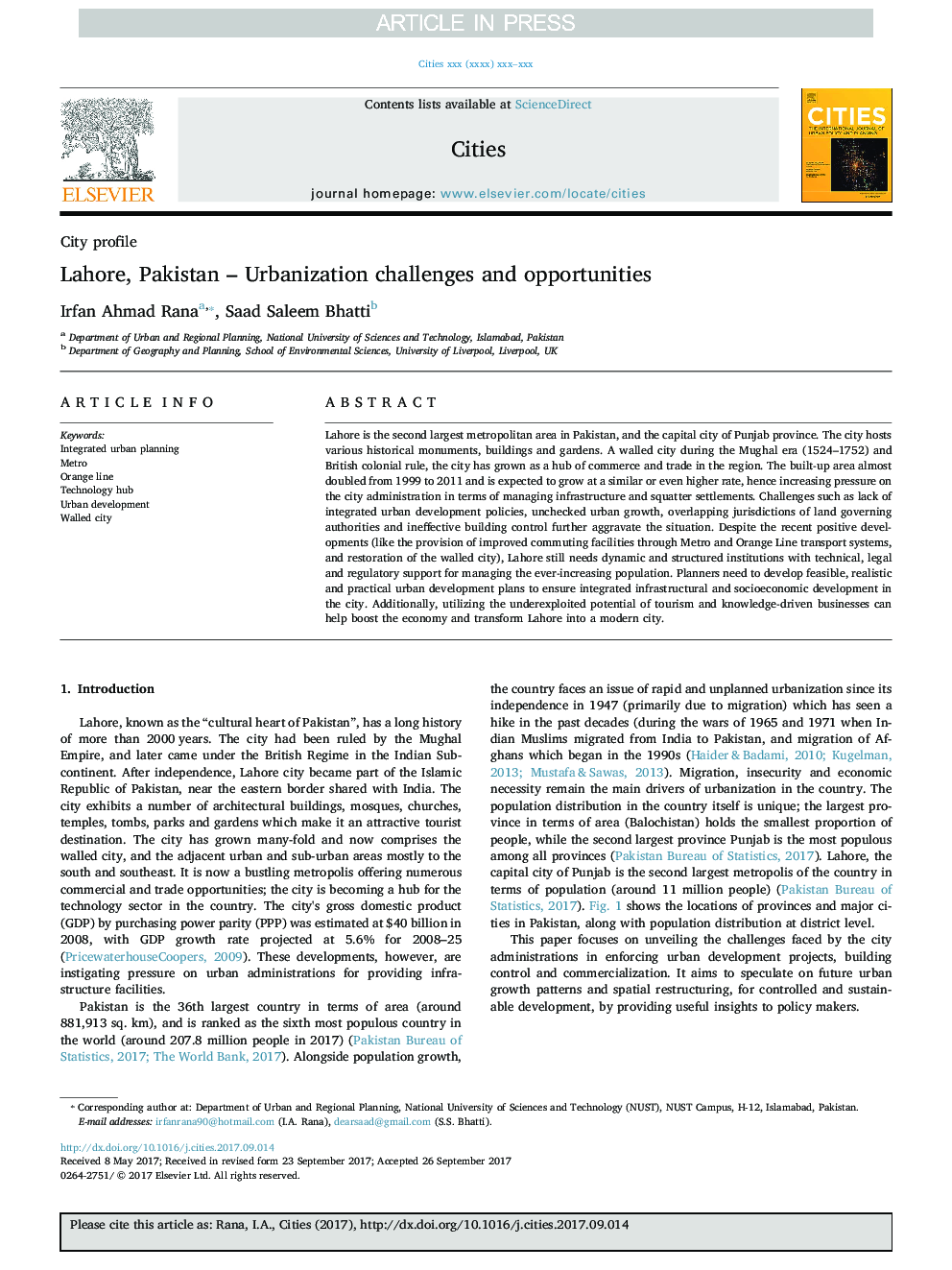| کد مقاله | کد نشریه | سال انتشار | مقاله انگلیسی | نسخه تمام متن |
|---|---|---|---|---|
| 7417777 | 1482323 | 2018 | 8 صفحه PDF | دانلود رایگان |
عنوان انگلیسی مقاله ISI
Lahore, Pakistan - Urbanization challenges and opportunities
ترجمه فارسی عنوان
لاهور پاکستان - چالش ها و فرصت های شهرسازی
دانلود مقاله + سفارش ترجمه
دانلود مقاله ISI انگلیسی
رایگان برای ایرانیان
کلمات کلیدی
برنامه ریزی شهری یکپارچه، مترو، خط نارنجی، مرکز فناوری، توسعه شهری، شهر گردن
ترجمه چکیده
لاهور دومین منطقه بزرگ شهری در پاکستان و شهر پایتخت پنجاب است. این شهر میزبان آثار تاریخی مختلف، ساختمان ها و باغ ها است. این شهر در طول دوران مغول (1524-1752) و حکومت استعماری انگلیس، شهر به عنوان مرکز تجارت و تجارت در منطقه رشد کرده است. مساحت ساخته شده از سال های 1999 تا 2011 تقریبا دو برابر شده است و انتظار می رود که این نرخ در همان سطح یا حتی بالاتر رشد کند و از این رو فشار بر مدیریت شهری از نظر مدیریت زیرساخت ها و شهرک سازی های فکری افزایش می یابد. چالش هایی مانند فقدان سیاست های توسعه یکپارچه شهری، رشد شهری غیرقابل کنترل، اختلاف نظر در حوزه های حاکم بر حکومت های حاکم بر زمین و کنترل ساختمانی غیرمستقیم، وضعیت را تشدید می کند. با وجود تحولات مثبت اخیر (مانند ارائه امکانات پیشرفته رفت و آمد از طریق سیستم های حمل و نقل مترو و نارنجی و بازگرداندن شهر دیوار)، لاهور هنوز نیاز به موسسات پویا و ساختار یافته با حمایت فنی، قانونی و نظارتی برای مدیریت جمعیت رو به رشد . برنامه ریزان باید برنامه های توسعه ای قابل اجرا، واقع بینانه و عملی را برای ایجاد یکپارچه زیربنایی و توسعه اجتماعی و اقتصادی در شهر توسعه دهند. علاوه بر این، بهره برداری از پتانسیل کم بهره برداری از گردشگری و کسب و کار مبتنی بر دانش می تواند به تقویت اقتصاد و تبدیل لاهور به یک شهر مدرن کمک کند.
موضوعات مرتبط
علوم انسانی و اجتماعی
مدیریت، کسب و کار و حسابداری
گردشگری، اوقات فراغت و مدیریت هتلداری
چکیده انگلیسی
Lahore is the second largest metropolitan area in Pakistan, and the capital city of Punjab province. The city hosts various historical monuments, buildings and gardens. A walled city during the Mughal era (1524-1752) and British colonial rule, the city has grown as a hub of commerce and trade in the region. The built-up area almost doubled from 1999 to 2011 and is expected to grow at a similar or even higher rate, hence increasing pressure on the city administration in terms of managing infrastructure and squatter settlements. Challenges such as lack of integrated urban development policies, unchecked urban growth, overlapping jurisdictions of land governing authorities and ineffective building control further aggravate the situation. Despite the recent positive developments (like the provision of improved commuting facilities through Metro and Orange Line transport systems, and restoration of the walled city), Lahore still needs dynamic and structured institutions with technical, legal and regulatory support for managing the ever-increasing population. Planners need to develop feasible, realistic and practical urban development plans to ensure integrated infrastructural and socioeconomic development in the city. Additionally, utilizing the underexploited potential of tourism and knowledge-driven businesses can help boost the economy and transform Lahore into a modern city.
ناشر
Database: Elsevier - ScienceDirect (ساینس دایرکت)
Journal: Cities - Volume 72, Part B, February 2018, Pages 348-355
Journal: Cities - Volume 72, Part B, February 2018, Pages 348-355
نویسندگان
Irfan Ahmad Rana, Saad Saleem Bhatti,
